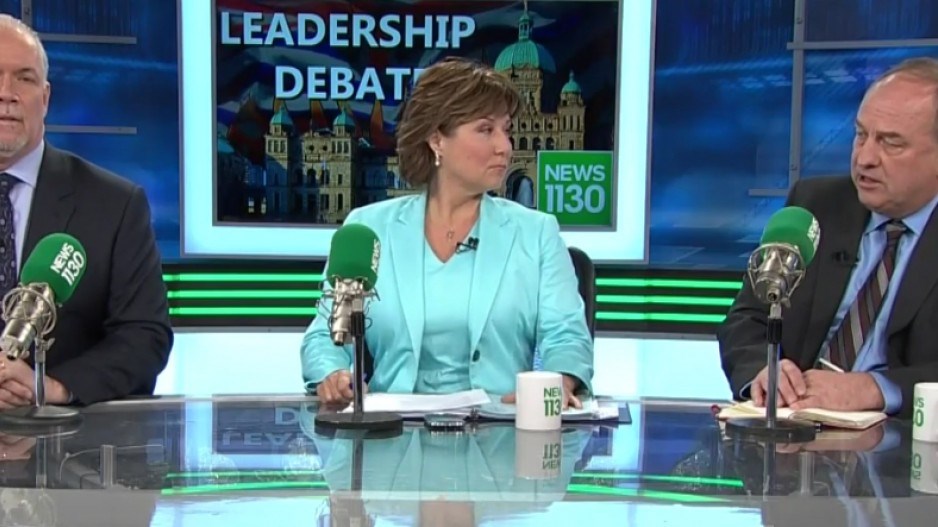Premier Christy Clark is stuck with a minority government, following a final vote count, and all eyes are now on Green Party Leader Andrew Weaver, who holds the balance of power.
A final tally of absentee ballots completed May 24 failed to change the distribution of seats that resulted from the May 9 provincial election’s initial vote: Liberal 43, NDP 41 and Green 3. The Liberals won 40.36% of the popular vote, the NDP 40.28% and the Greens 16.84%.
The one potential wild card was Courtenay-Comox, which the NDP won by just nine votes in the initial May 9 count.
Had a final tally of absentee votes swung it to the Liberals, Clark would have had the 44 seats needed for a majority government. But a count of absentee ballots cemented the NDP’s hold on that riding.
The final count for Courtenay-Comox was 10,886 for the NDP and 10,697 for the Liberals. With a spread of 189 votes, that means no judicial recount is required.
The question now is: will Clark’s Liberals be able to continue governing as a minority government or will Weaver and NDP Leader John Horgan try to deny her that right by forming a coalition?
“With 43 BC Liberal candidates elected as MLAs, and a plurality in the legislature, we have a responsibility to move forward and form government,” Clark said in a written statement. “The final result reinforces that British Columbians want us to work together, across party lines, to get things done for them.”
But left-of-centre forces in B.C. are pushing for some kind of pact between the Greens and NDP.
In a press conference late Wednesday afternoon, Weaver said negotiations with both the NDP and Liberals are ongoing, and pledged to let British Columbians know by May 31, when the writ is returned to the lieutenant-governor, what his decision will be.
"We recognize that British Columbians want stability," Weaver said. "They want this government to work. We're committed to bringing stability to this province and we're committed to ensure that the decisions that we make in the next days are those that actually make government work in British Columbia."
Seizing power from the Liberals through a Green-NDP coalition would not be as easy as it might sound, according to Richard Johnston, political science professor at the University of British Columbia and Canada Research chairman of Public Opinion, Elections and Representation.
“I think a coalition is unlikely, and it’s unnecessary,” Johnston said.
Weaver and NDP Leader John Horgan could agree to form a coalition and ask the lieutenant-governor to allow them to form the government.
Such a coalition would require Weaver to whip his caucus to vote in line with the NDP. Weaver has promised he would allow his caucus free votes.
Weaver is under pressure from some Green Party supporters and social justice organizations like Leadnow to form some kind of co-operative alliance with the NDP to advance common environmental and social policy planks.
One is electoral and campaign financing reform. Another is trying to halt the Trans Mountain pipeline expansion. The Greens and NDP also support universal child care, although their visions differ.
Both also oppose the Liberals’ $3.5 billion George Massey Tunnel replacement project and the $8.8 billion Site C dam project.
But Weaver disagrees with the NDP's plan to scrap bridge tolls and has a more aggressive plan to raise carbon taxes.
Johnston thinks it unlikely that Weaver would agree to a formal coalition with either the Liberals or NDP, but would more likely opt to remain a free agent with considerable political brokering powers.
In a coalition with the NDP, the Greens would be like a sapling starved of sunlight in the shadow of an old-growth giant.
“If he [Weaver] wants to develop the separate identity of his party, so as to grow it in the future, better he do so as a quasi-free agent than as a minister in somebody else's cabinet,” Johnston said.
Even if the NDP and Greens did decide to strike a formal coalition, that doesn’t automatically mean the lieutenant-governor would let them form government, Johnston said.
“The lieutenant-governor cannot meet with them unless and until Christy Clark submits her resignation,” he said. “She is the premier of the province until somebody says that she can’t [govern].
“Even if Horgan and Weaver announce an agreement on the basis of which they shall govern, the lieutenant-governor cannot herself dismiss the premier and summon John Horgan.”
The process would take some time. Clark’s government would have to be defeated on a confidence vote – budget or throne speech, for example. In that case, Clark would go to the lieutenant-governor and ask her to dissolve the legislature and call an election.
“Under those circumstances, precedent suggests that the lieutenant-governor should refuse her request because there appears to be a viable alternative government in the house as presently constituted, and at that point Horgan is summoned,” Johnston said.
Johnston said a more likely scenario is that Weaver would agree to strike a supply and confidence agreement in which the Greens would support the Liberal government on things like budgets, while reserving the right to vote with the Opposition on other bills.
While the Liberals could survive as a minority government for a year or two, it’s not guaranteed that Clark will survive.
Dissidents within the Liberal Party might hold Clark responsible for losing five seats and push for a leadership contest. Or Clark could decide to call one herself.




